带花树-一般图最大匹配
带花树
顾名思义,带花树是一种自带花朵的树(x)
带花树其实并不是什么数据结构 ,它是一种以图为基础的 【匹配】 算法,常见于一般图匹配。
生活中的匹配问题最常见是二分图匹配 ,一些匹配 也可以贪心 / DP 完成 ,但是遇到一般图,就很难跑出正确的匹配结果并输出了。
介绍算法、讲解算法,我觉得各位巨巨【链接在底下】讲的已经十分清楚了,所以不再重复【主要是我觉得我讲的不比他们好】,但是网上好像还没人模拟带花树算法的过程,所以决定试一下模拟几个样例。
一:各个变量的含义:

二:算法核心:
匈牙利解决二分图偶环+奇环处理,其中使用的是匈牙利BFS版本解决二分图的情况
三:各个函数的介绍:
①主接口函数【返回一般图最大匹配】 很像二分图最大匹配的代码
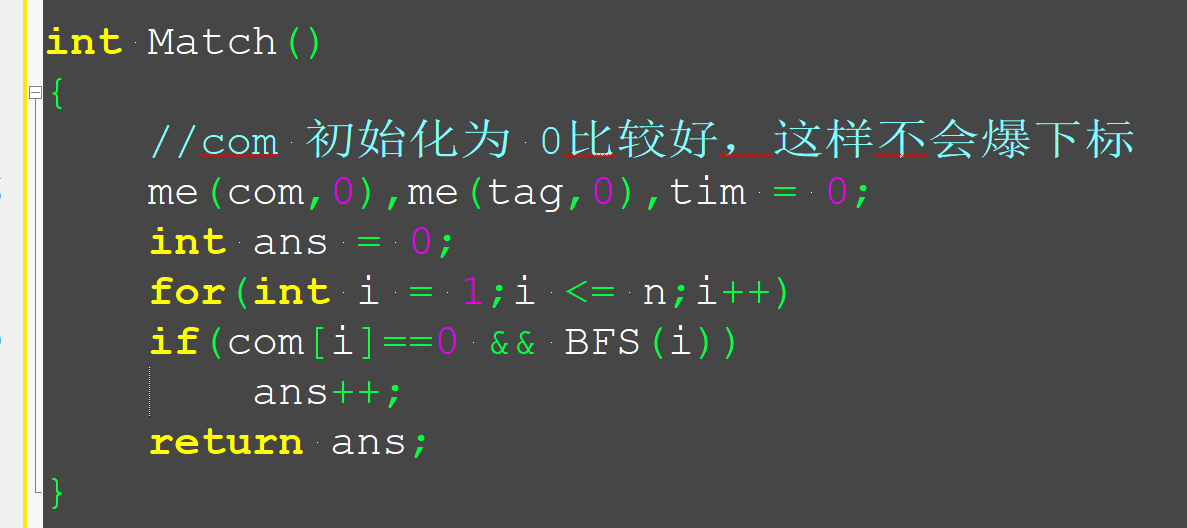
②主函数BFS 用于搜索【增广路】
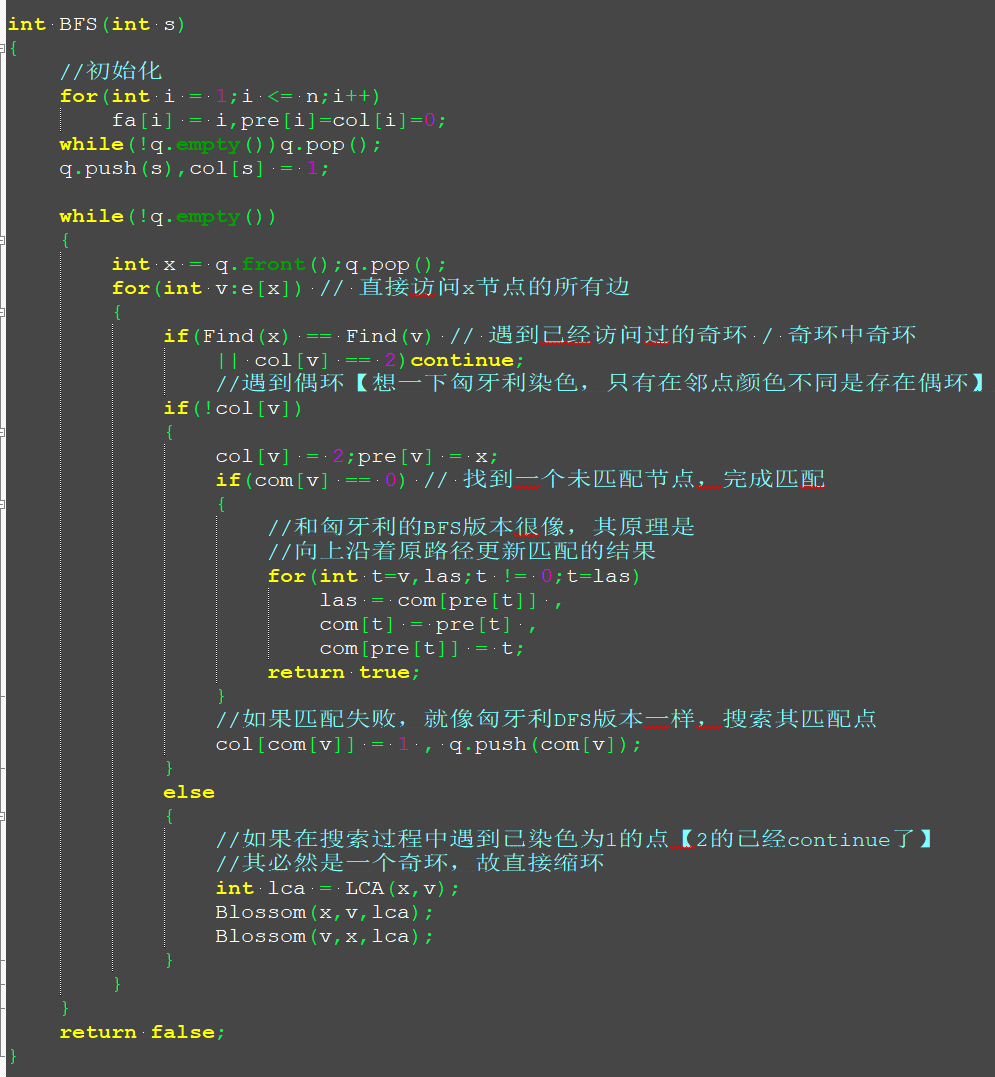
③并查集代码+【pre指针和com指针共同作用下维护着一条原路径,可以理解为树的一条可以跳越的边】维护LCA代码

④缩环代码
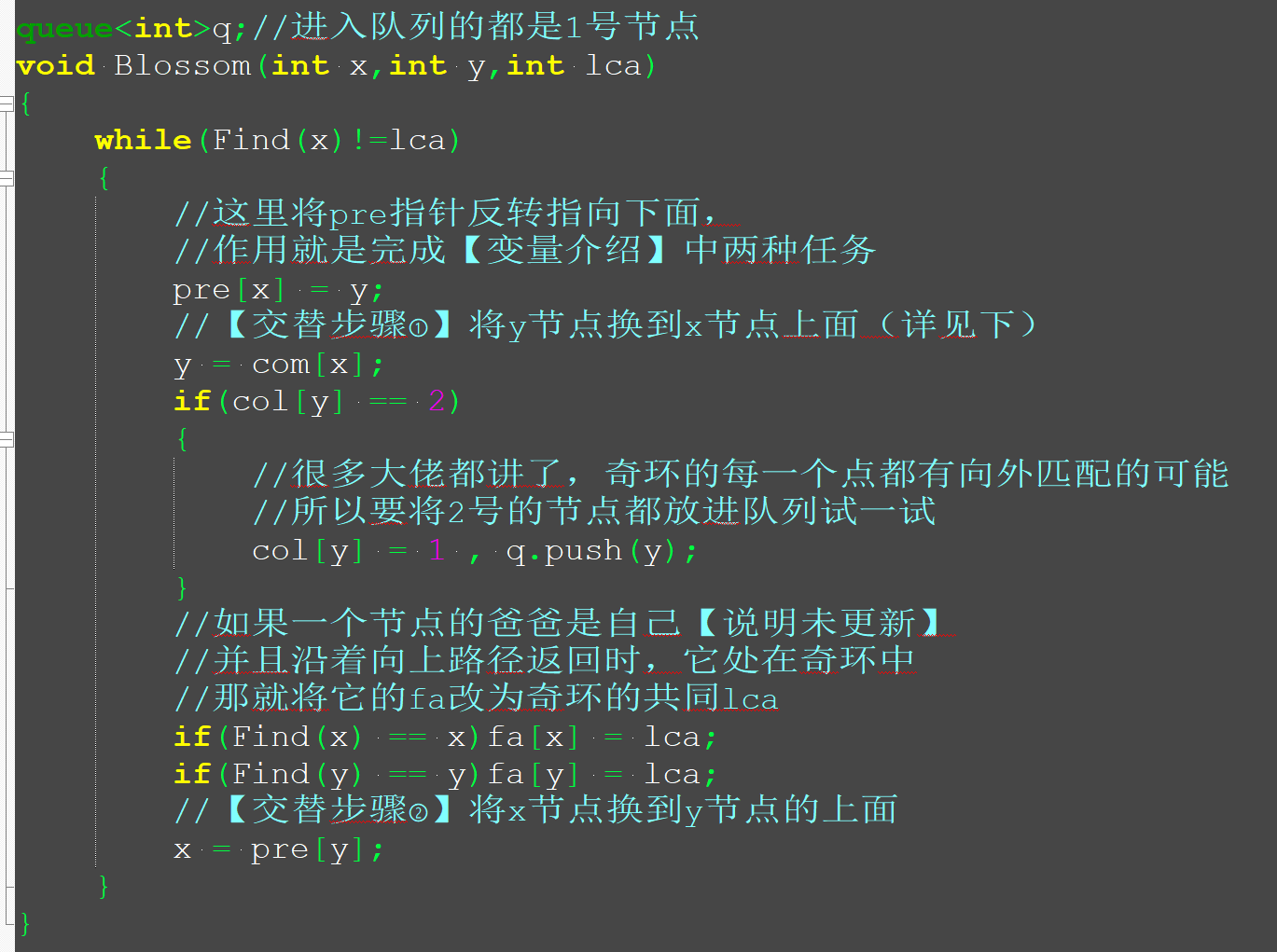
四:例子模拟
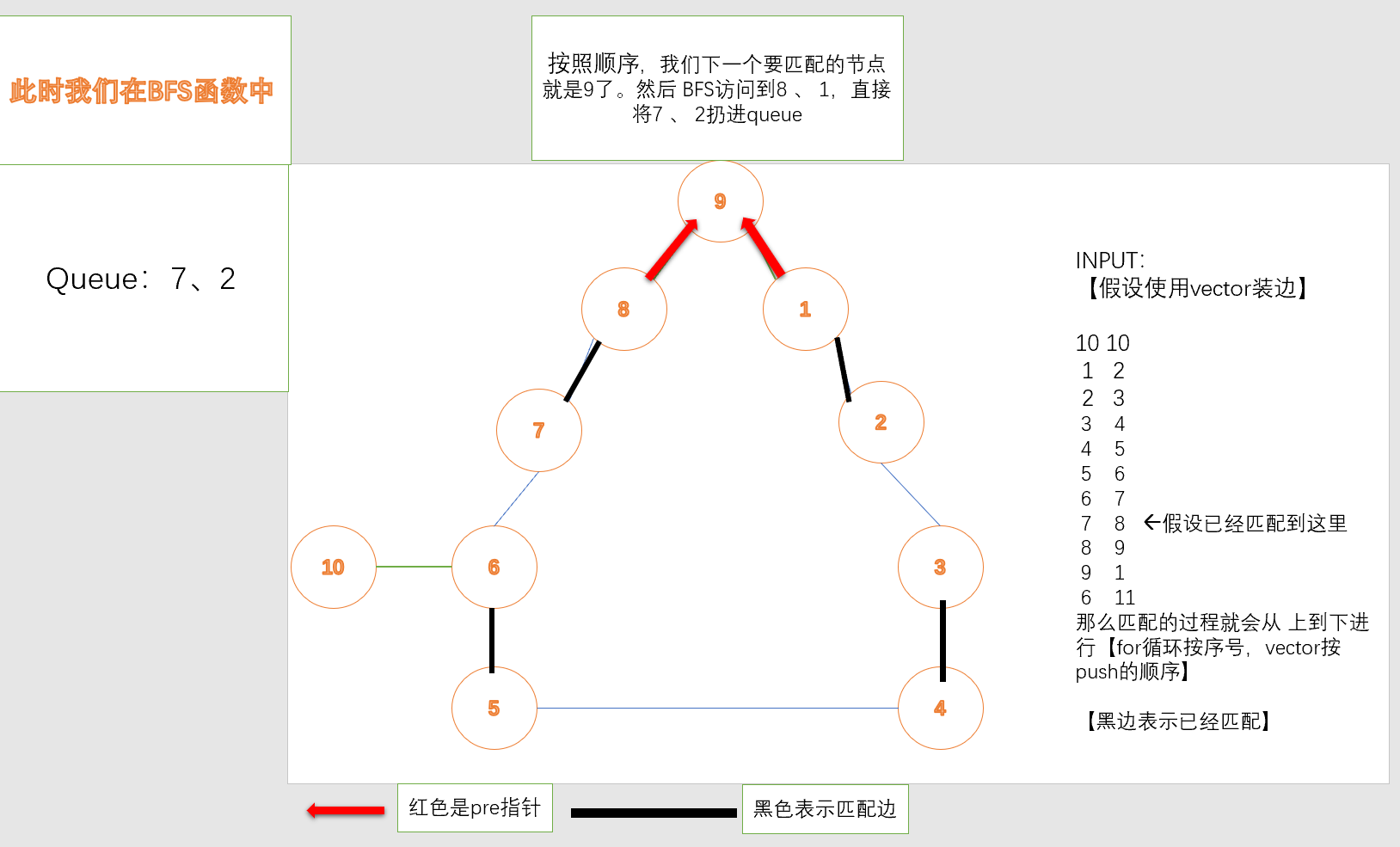
因为每次进入BFS函数都是未匹配的点,8已经被遍历到7时匹配了,所以直接跳过。
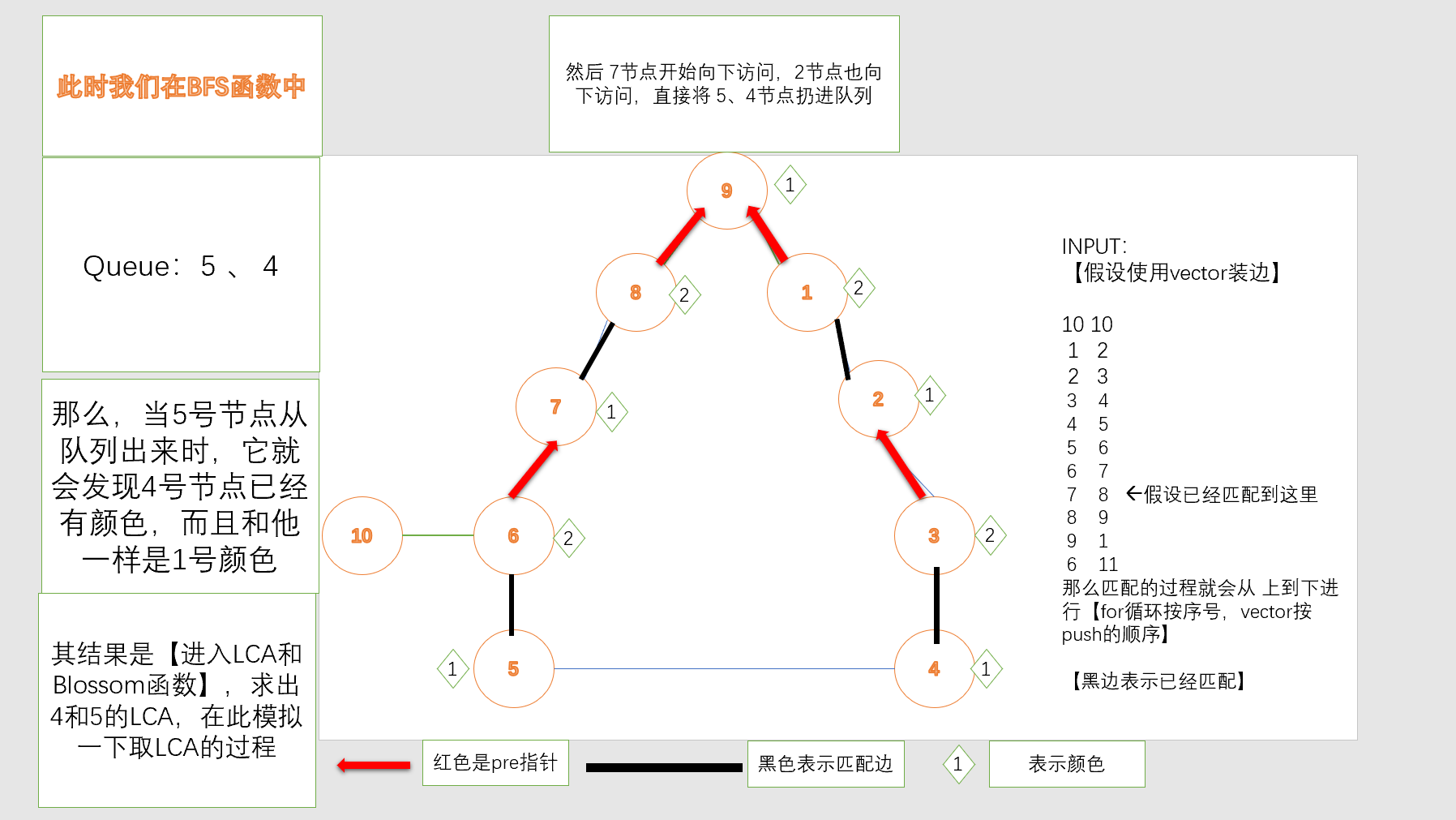
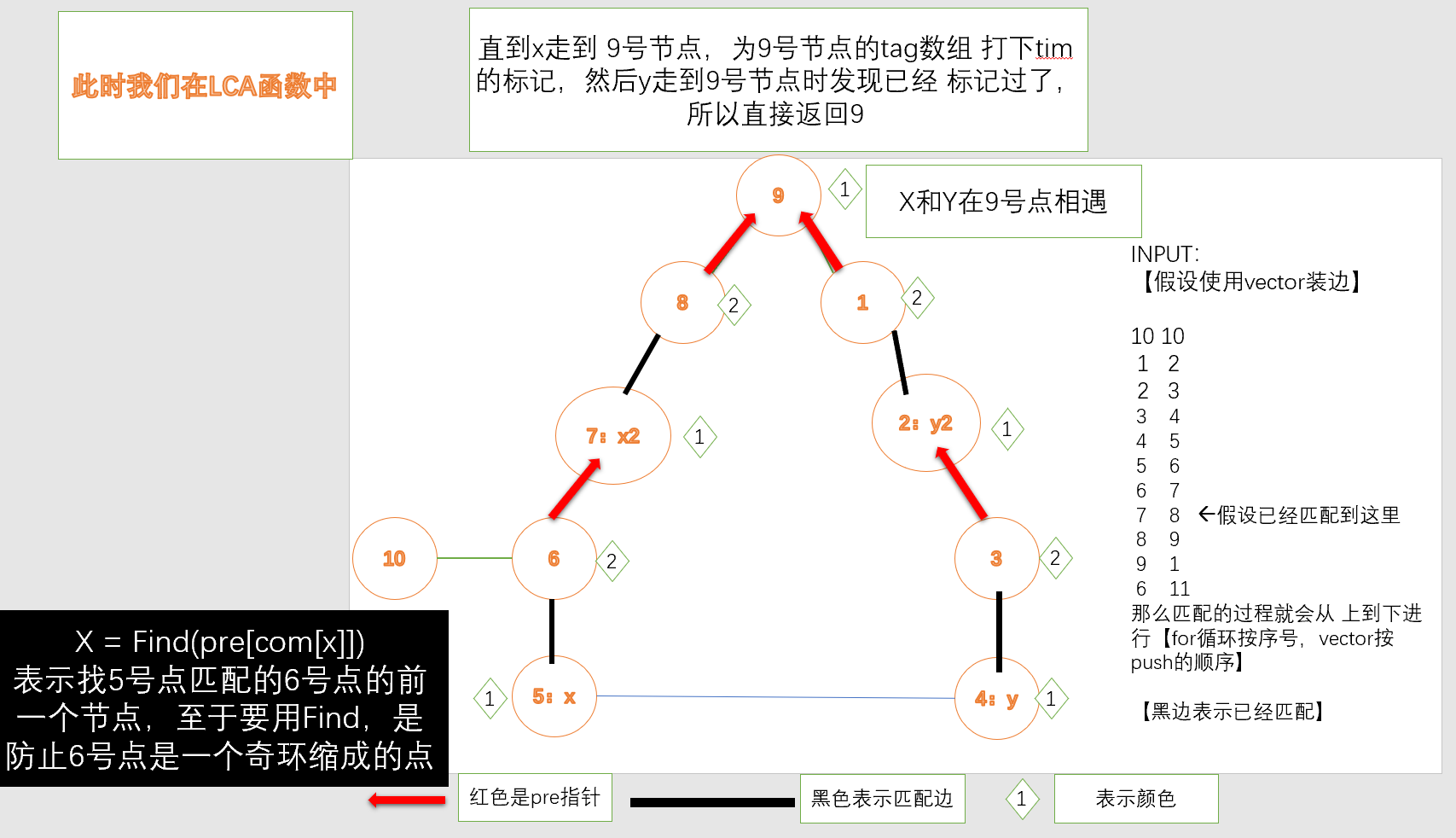
【介绍完LCA函数,直接介绍重点:Blossom函数,为什么缩环的每一步都必不可少】
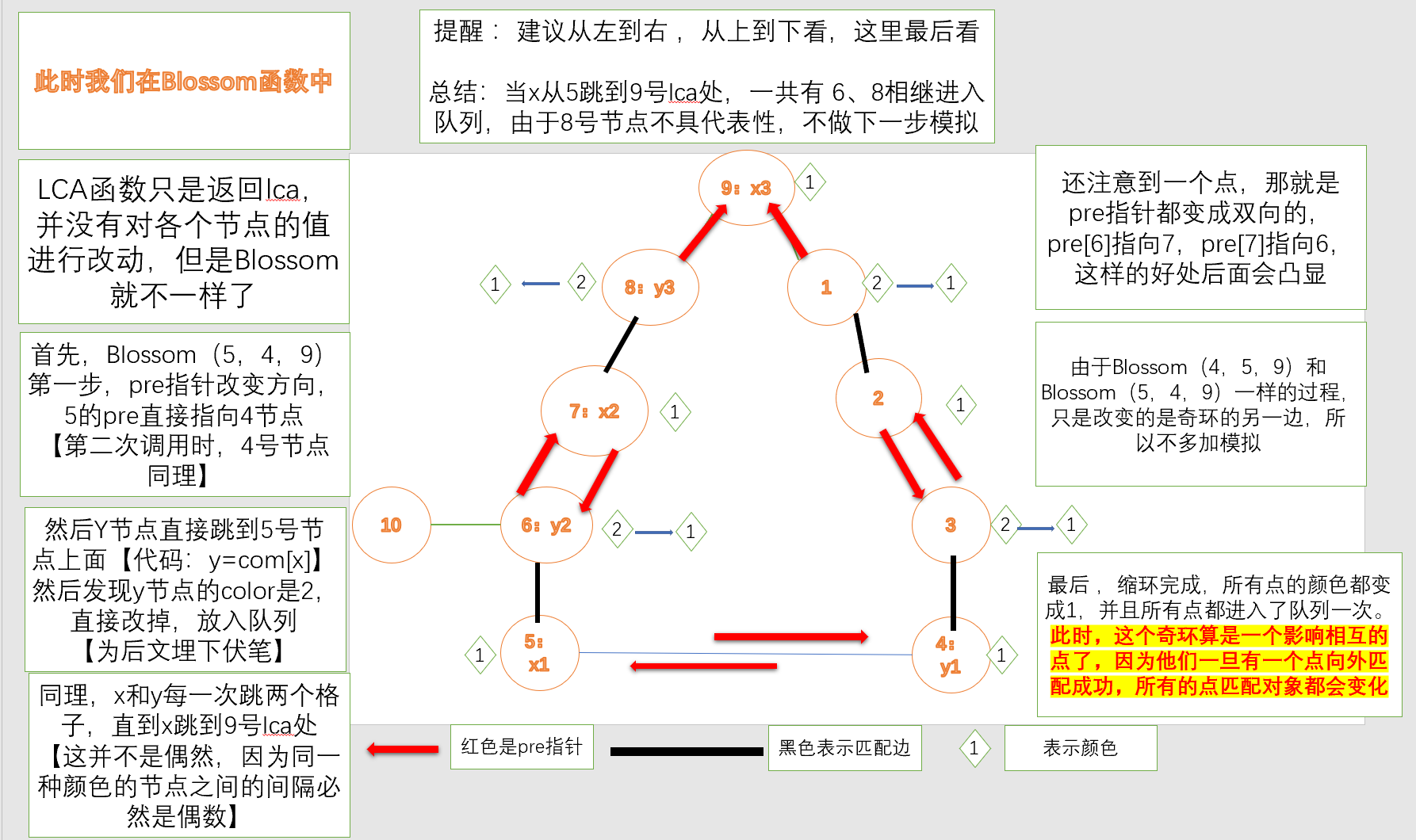
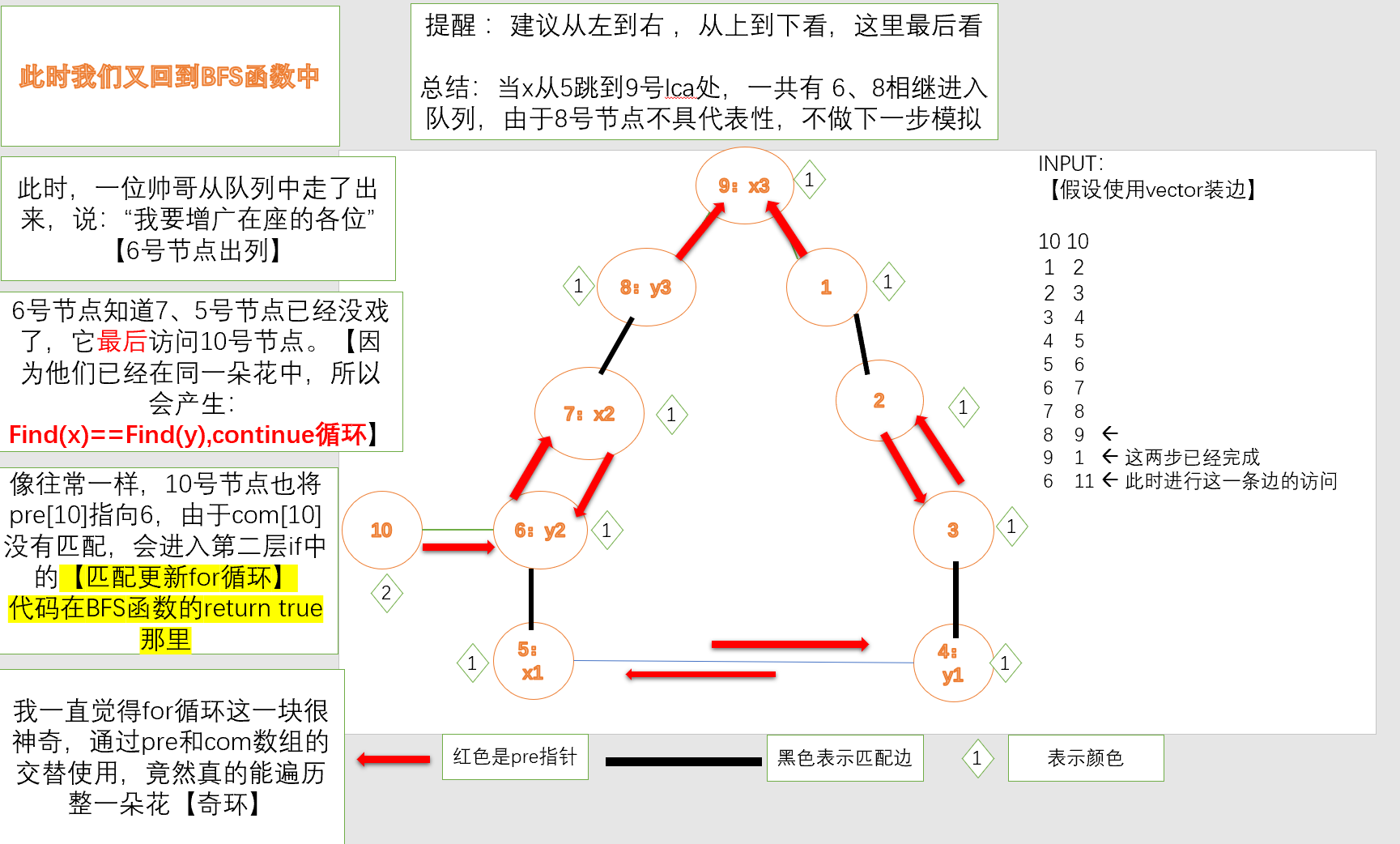
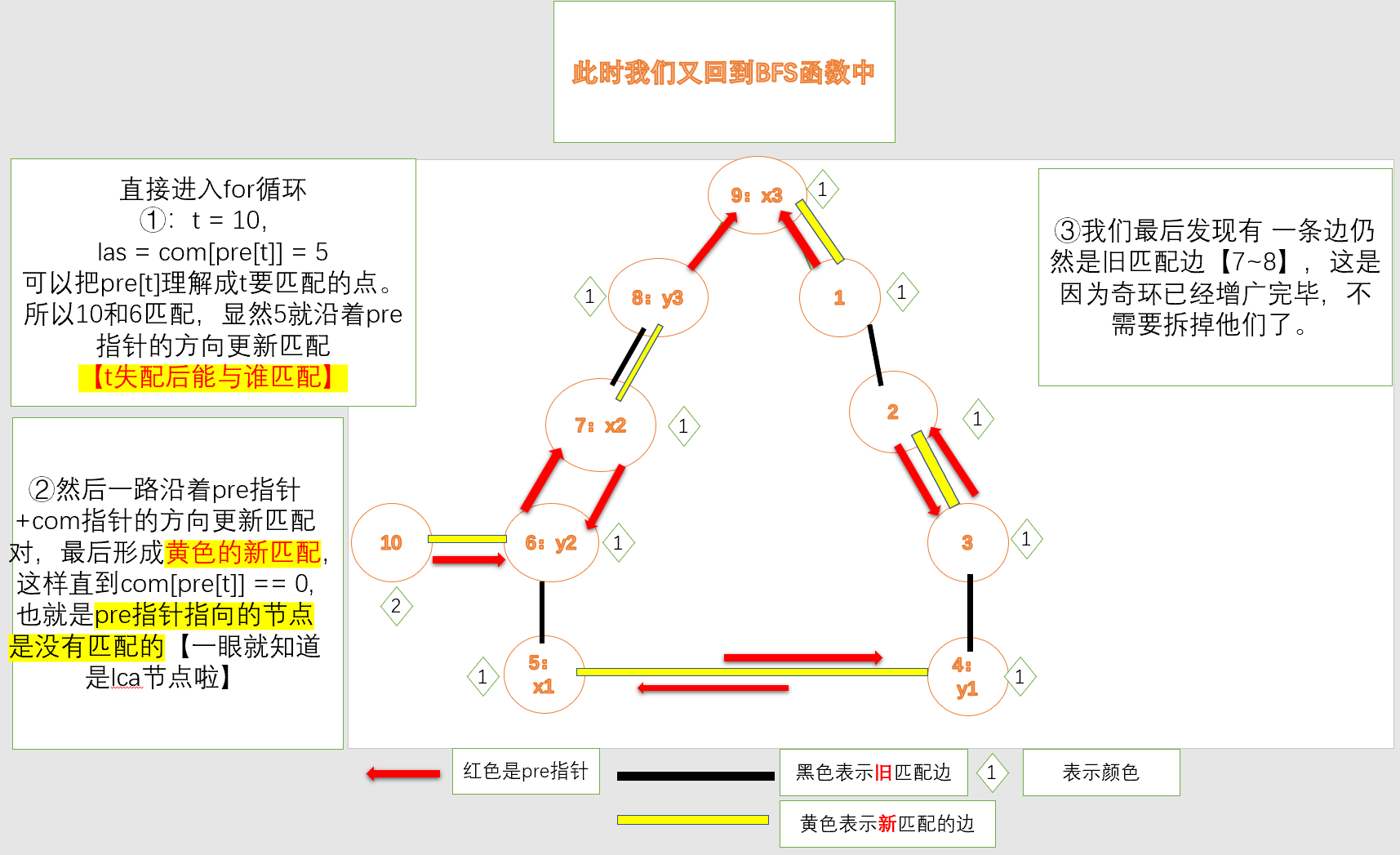
五:笔者的补充
模拟的样例虽然只有一个,但是用到了带花树算法的绝大部分代码,算是经典的样例,但是更复杂时会出现花套花的现象,不过处理方法与上面不禁相同,可以缩两次花解决掉。
模拟的目的是帮助大家
①更好地理解pre数组和match数组(我代码是com数组),是如何形成双向链表的
②更好地理解for循环更新奇环匹配的过程。
当然,理解了只是表层,如何更好地运用?如何解决特殊问题?都有待各位想出实际的做法。

namespace Match { int com[maxn], col[maxn]; int tim, tag[maxn], N; int fa[maxn], pre[maxn]; vector<vector<int>> e; inline int Find(int x) { return x == fa[x] ? x : fa[x] = Find(fa[x]); } inline int LCA(int x, int y) { ++tim; while (tag[x] != tim) { tag[x] = tim; x = Find(pre[com[x]]); if (y) swap(x, y); } return x; } queue<int> q; inline void Blossom(int x, int y, int lca) { while (Find(x) != lca) { pre[x] = y, y = com[x]; if (col[y] == 2) col[y] = 1, q.push(y); if (Find(x) == x) fa[x] = lca; if (Find(y) == y) fa[y] = lca; x = pre[y]; } } inline int BFS(int S) { for (int i = 1; i <= N; i++) fa[i] = i, col[i] = pre[i] = 0; while (!q.empty()) q.pop(); q.push(S), col[S] = 1; while (!q.empty()) { int x = q.front(); q.pop(); for (int &v : e[x]) { if (Find(v) == Find(x) || col[v] == 2) continue; if (!col[v]) { col[v] = 2, pre[v] = x; if (com[v] == 0) { for (int t = v, las; t != 0; t = las) las = com[pre[t]], com[t] = pre[t], com[pre[t]] = t; return 1; } col[com[v]] = 1, q.push(com[v]); } else { int lca = LCA(x, v); Blossom(x, v, lca); Blossom(v, x, lca); } } } return 0; } inline int maxMatch() { me(com, 0), me(tag, 0), tim = 0; int ans = 0; for (int i = 1; i <= N; i++) if (com[i] == 0 && BFS(i)) ans++; return ans; } // 初始化图,并且设置节点数量 inline void initMaxMatch(int n) { N = n, e.assign(n + 1, vector<int>()); } }; // namespace Match using namespace Match;
题库:
(1)Luogu:板子题
(2)UOJ79:传送门
(3)Kuangbin带你飞 :传送门
HDU: 带花树--除去多余组合【多余组合:删掉这个组合之后,会使最大匹配的结果-2(因为本来这个组合的两个端点分别属于不同的匹配对,删掉之后两个匹配对都没了,所以-2。如果不是多余,即本来他们有机会组合在一起,所以删掉他们只会 使得最大匹配结果-1)】【例如下图,删去任意两个节点的所有边(甚至删去节点),剩下图的匹配对都只是-1】


比如 样例1: 1 - 3 - 2 - 4 ,去掉2-3,最大匹配-2.
【如果选了2-3作为匹配,那么匹配的数量就是1了,但是正确的最大匹配是2 】
注意一下输出的格式,就算0也要加多一个换行

//#pragma GCC optimize(3, "inline", "-Ofast") #include <bits/stdc++.h> #include <ext/pb_ds/priority_queue.hpp> #define lowbit(x) (x & (-x)) //-为按位取反再加1 #define mseg ((l + r) >> 1) #define ls (ro << 1) #define rs ((ro << 1) | 1) #define ll long long #define lld long double #define uint unsigned int #define ull unsigned long long #define fi first #define se second #define pln puts("") #define ios_fast ios_base::sync_with_stdio(0), cin.tie(0), cout.tie(0) #define deline cout << "-----------------------------------------" << endl #define de(a) cout << #a << " = " << a << endl #define de2(a, b) de(a), de(b), deline #define de3(a, b, c) de(a), de(b), de(c), deline #define de4(a, b, c, d) de(a), de(b), de(c), de(d), deline #define emp(a) push_back(a) #define iter(c) __typeof((c).begin()) #define PII pair<int, int> #define PLL pair<ll, ll> #define me(x, y) memset((x), (y), sizeof(x)) #define mp make_pair using namespace std; /////快读 template <typename T> inline void read(T &res) { // T x = 0, f = 1; char ch = getchar(); while (ch != EOF && (ch < '0' || ch > '9')) { if (ch == '-') f = -1; ch = getchar(); } while (ch != EOF && ch >= '0' && ch <= '9') { x = (x << 1) + (x << 3) + (ch ^ 48); ch = getchar(); } res = x * f; } template <typename T, typename... Args> inline void read(T &t, Args &...a) { read(t), read(a...); } const int inf_int = 0x3f3f3f3f; const ll inf_ll = 0x3f3f3f3f3f3f, inf_2 = 4e13 + 11; const ll maxn = 2e3 + 3, maxe = 5e5 + 11, mod = 998244353; const lld eps = 1e-8; int n, m, k, t1, t2, t3; namespace Match { int com[maxn], col[maxn]; int tim, tag[maxn], N, banU, banV; int fa[maxn], pre[maxn]; vector<vector<int>> e; inline int Find(int x) { return x == fa[x] ? x : fa[x] = Find(fa[x]); } inline int LCA(int x, int y) { ++tim; while (tag[x] != tim) { tag[x] = tim; x = Find(pre[com[x]]); if (y) swap(x, y); } return x; } queue<int> q; inline void Blossom(int x, int y, int lca) { while (Find(x) != lca) { pre[x] = y, y = com[x]; if (col[y] == 2) col[y] = 1, q.push(y); if (Find(x) == x) fa[x] = lca; if (Find(y) == y) fa[y] = lca; x = pre[y]; } } inline int BFS(int S) { for (int i = 1; i <= N; i++) fa[i] = i, col[i] = pre[i] = 0; while (!q.empty()) q.pop(); q.push(S), col[S] = 1; while (!q.empty()) { int x = q.front(); q.pop(); if (x == banU || x == banV) continue; // 特判这个点是不是被删除 for (int &v : e[x]) { if (v == banV || v == banU) continue; // 特判这条边是不是不能使用 if (Find(v) == Find(x) || col[v] == 2) continue; if (!col[v]) { col[v] = 2, pre[v] = x; if (com[v] == 0) { for (int t = v, las; t != 0; t = las) las = com[pre[t]], com[t] = pre[t], com[pre[t]] = t; return 1; } col[com[v]] = 1, q.push(com[v]); } else { int lca = LCA(x, v); Blossom(x, v, lca); Blossom(v, x, lca); } } } return 0; } inline int maxMatch() { me(com, 0), me(tag, 0), tim = 0; int ans = 0; for (int i = 1; i <= N; i++) if (com[i] == 0 && BFS(i)) ans++; return ans; } // 初始化图,并且设置节点数量 inline void initMaxMatch(int n) { N = n, e.assign(n + 1, vector<int>()); } }; // namespace Match using namespace Match; void solve() { vector<PII> pe; initMaxMatch(n); for (int i = 1, x, y; i <= m; i++) { read(x, y); e[x].emp(y), e[y].emp(x); pe.emp(mp(x, y)); } banU = banV = 0; int mx = maxMatch(); vector<int> ans; for (int i = 1; i <= m; i++) { banU = pe[i - 1].fi, banV = pe[i - 1].se; if (maxMatch() == mx - 2) ans.emp(i); } printf("%d\n", ans.size()); for (int i = 0; i < ans.size(); i++) { if (i) printf(" "); printf("%d", ans[i]); } pln; } int main() { // freopen("test_input.txt", "r", stdin); // freopen("test_output.txt", "w", stdout); int TEST = 1; // read(TEST); while (~scanf("%d%d", &n, &m)) solve(); } /* */
(4)ZOJ3316:Game
跑带花树,最后再跑n次com[I],check一下。【不知道为什么Match()==n/2 会错 】

#include <stdio.h> #include <iostream> #include <ctime> #include <cstring> #include <algorithm> #include <queue> #include <map> #include <set> #include <stack> #pragma GCC optimize(3) #define lowbit(x) (x&~x)//~为按位取反再加1 #define re register #define ls (ro<<1) #define rs ((ro<<1)|1) #define ll long long #define ull unsigned long long #define fi first #define se second #define de(a) cerr<<#a<<" = "<<a<<endl #define emp(a) emplace_back(a) #define iter(c) __typeof((c).begin()) #define ios ios::sync_with_stdio(0),cin.tie(0),cout.tie(0) #define me(a,b) memset(a,(b),sizeof a) using namespace std; inline ll max(ll a,ll b){return a>b?a:b;} inline ll min(ll a,ll b){return a>b?b:a;} template<typename T>inline int read(T&res){ ll x=0,f=1,flag=0;char ch; flag=ch=getchar(); if(flag==-1)return -1; while(ch<'0'||ch>'9'){ if(ch=='-')f=-1; flag=ch=getchar(); if(flag==-1)return -1; } while(ch>='0'&&ch<='9'&&flag!=-1){ x=(x<<1)+(x<<3)+(ch^48); flag=ch=getchar(); } res = x*f;return flag; } template<typename T,typename...Args> inline int read(T&t,Args&...a){ int res; res=read(t);if(res==-1)return -1; res=read(a...);return res; } const int maxn = 555,inf = 0x3f3f3f3f; int com[maxn],col[maxn]; int tim,tag[maxn]; int fa[maxn],pre[maxn]; int n,m,a,b,c,L; vector<int>e[maxn]; struct stone { int x,y,id; }s[maxn]; inline int Find(int x){return x==fa[x]?x:fa[x]=Find(fa[x]);} inline int LCA(int x,int y) { ++tim; while(tag[x]!=tim) { tag[x] = tim; x = Find(pre[com[x]]); if(y)swap(x,y); } return x; } queue<int>q; inline void Blossom(int x,int y,int lca) { while(Find(x)!=lca) { pre[x] = y , y = com[x]; if(col[y] == 2) col[y] = 1,q.push(y); if(Find(x)==x)fa[x] = lca; if(Find(y)==y)fa[y] = lca; x = pre[y]; } } inline int BFS(int S) { for(int i = 1;i <= n;i++) fa[i]=i,col[i]=pre[i]=0; while(!q.empty())q.pop(); q.push(S),col[S]=1; while(!q.empty()) { int x = q.front();q.pop(); for(int v:e[x]) { if(Find(v) == Find(x) || col[v] == 2)continue; if(!col[v]) { col[v] = 2; pre[v] = x; if(com[v] == 0) { for(int t=v,las;t != 0;t=las) las = com[pre[t]], com[t] = pre[t], com[pre[t]] = t; return 1; } col[com[v]] = 1,q.push(com[v]); } else { int lca = LCA(x,v); Blossom(x,v,lca); Blossom(v,x,lca); } } } return 0; } int Match() { me(com,0),me(tag,0),tim = 0; int ans = 0; for(int i = 1;i <= n;i++) if(com[i] ==0 && BFS(i)) ans++; return ans; } bool check() { for(int i = 1;i <= n;i++) if(com[i]==0)return 0; return 1; } void solve() { for(int i = 0;i <= n;i++)e[i].clear(); for(int i = 1;i <= n;i++) { scanf("%d%d",&s[i].x,&s[i].y); s[i].id = i; } read(L); for(int i = 1;i <= n;i++) { for(int j = 1+i;j <= n;j++) { if(abs(s[i].x-s[j].x)+abs(s[i].y-s[j].y)<=L) e[i].emp(j),e[j].emp(i); } } int ans = Match(); //de(ans); if(check())puts("YES"); else puts("NO"); } int main() { //这些ifdef要在main函数里面 #ifndef ONLINE_JUDGE //freopen("rand.in","r",stdin); //freopen("baoli.out","w",stdout); ll sta = clock(); #endif int t = 1,kase = 1; //~scanf("%d",&t); //while(t--) while(~read(n)) solve(); #ifndef ONLINE_JUDGE ll en = clock(); cerr<<"运行时间"<<(double)(en-sta)<<"ms"<<endl; #endif }
(5)UOJ171:挑战NPC 【拆点建图】
关于这道题的理解:由于一个框拆成了3个框,所以对答案起作用的部分只有:两个框之间的匹配。
①如果该框有0个球,那么匹配数为1,属于两个框之间的匹配,答案+1
②如有一个球,那么匹配数为2,其中只有一个属于了两个框的匹配,答案+1
③对于2,3个球的情况,匹配数为球的数量,两个框不可能存在匹配,所以答案为0。
综上,每个框对最大匹配的贡献 = 该框内球的数量 + 两个分框的匹配数
又由于题目强制所有球都要放进去,所以半框的答案就是: maxMatch - n

#include <stdio.h> #include <iostream> #include <ctime> #include <cstring> #include <algorithm> #include <queue> #include <map> #include <set> #include <stack> #pragma GCC optimize(3) #define lowbit(x) (x&~x)//~为按位取反再加1 #define re register #define ls (ro<<1) #define rs ((ro<<1)|1) #define ll long long #define ull unsigned long long #define fi first #define se second #define de(a) cerr<<#a<<" = "<<a<<endl #define emp(a) emplace_back(a) #define iter(c) __typeof((c).begin()) #define ios ios::sync_with_stdio(0),cin.tie(0),cout.tie(0) #define me(a,b) memset(a,(b),sizeof a) using namespace std; inline ll max(ll a,ll b){return a>b?a:b;} inline ll min(ll a,ll b){return a>b?b:a;} template<typename T>inline int read(T&res){ ll x=0,f=1,flag=0;char ch; flag=ch=getchar(); if(flag==-1)return -1; while(ch<'0'||ch>'9'){ if(ch=='-')f=-1; flag=ch=getchar(); if(flag==-1)return -1; } while(ch>='0'&&ch<='9'&&flag!=-1){ x=(x<<1)+(x<<3)+(ch^48); flag=ch=getchar(); } res = x*f;return flag; } template<typename T,typename...Args> inline int read(T&t,Args&...a){ int res; res=read(t);if(res==-1)return -1; res=read(a...);return res; } const int maxn = 3555,inf = 0x3f3f3f3f; int com[maxn],col[maxn]; int tim,tag[maxn]; int fa[maxn],pre[maxn]; int n,m,k,t1,t2,t3,a,b,c,L; vector<int>e[maxn]; inline int Find(int x){return x==fa[x]?x:fa[x]=Find(fa[x]);} inline int LCA(int x,int y) { ++tim; while(tag[x]!=tim) { tag[x] = tim; x = Find(pre[com[x]]); if(y)swap(x,y); } return x; } queue<int>q; inline void Blossom(int x,int y,int lca) { while(Find(x)!=lca) { pre[x] = y , y = com[x]; if(col[y] == 2) col[y] = 1,q.push(y); if(Find(x)==x)fa[x] = lca; if(Find(y)==y)fa[y] = lca; x = pre[y]; } } inline int BFS(int S) { for(int i = 1;i <= t3;i++) fa[i]=i,col[i]=pre[i]=0; while(!q.empty())q.pop(); q.push(S),col[S]=1; while(!q.empty()) { int x = q.front();q.pop(); for(int v:e[x]) { if(Find(v) == Find(x) || col[v] == 2)continue; if(!col[v]) { col[v] = 2; pre[v] = x; if(com[v] == 0) { for(int t=v,las;t != 0;t=las) las = com[pre[t]], com[t] = pre[t], com[pre[t]] = t; return 1; } col[com[v]] = 1,q.push(com[v]); } else { int lca = LCA(x,v); Blossom(x,v,lca); Blossom(v,x,lca); } } } return 0; } int Match() { me(com,0),me(tag,0),tim = 0; int ans = 0; for(int i = 1;i <= t3;i++) if(com[i] ==0 && BFS(i)) ans++; return ans; } void solve() { read(n,m,k); t1 = n+m,t2 = t1+m,t3 = t2+m; for(int i = 0;i <= t3;i++)e[i].clear(); for(int i = 1;i <= m;i++) { e[i+n].emp(i+t2),e[i+n].emp(i+t1); e[i+t1].emp(i+n),e[i+t1].emp(i+t2); e[i+t2].emp(i+n),e[i+t2].emp(i+t1); } for(int i = 1;i <= k;i++) { read(a,b); e[a].emp(b+n),e[a].emp(b+t2),e[a].emp(b+t1); e[b+n].emp(a),e[b+t2].emp(a),e[b+t1].emp(a); } int ans = Match(); printf("%d\n",ans-n); for(int i = 1;i <= n;i++) com[i]-=n,printf("%d ",(com[i]%m==0?m:com[i]%m)); puts(""); } int main() { //这些ifdef要在main函数里面 #ifndef ONLINE_JUDGE //freopen("rand.in","r",stdin); //freopen("baoli.out","w",stdout); ll sta = clock(); #endif int t = 1,kase = 1; ~scanf("%d",&t); while(t--) //while(~read(n)) solve(); #ifndef ONLINE_JUDGE ll en = clock(); cerr<<"运行时间"<<(double)(en-sta)<<"ms"<<endl; #endif }
题解转载这里
你可以列一个表格。
| 一个框子里放球的数量 | 0 | 1 | 2 | 3 |
|---|---|---|---|---|
| 对“半空框子”数量的贡献 | 1 | 1 | 0 | 0 |
把一个框子拆三个点。两两之间连边。
会发现,如果这三个点里一个都没有被球匹配掉,那么这三个点的最大匹配数是11;如果任意一个点被一个球匹配掉了,那么剩下两个点一定可以匹配,所以最大匹配数还是11;有两个点或者是三个点被匹配后最大匹配就是00。
所以,按如上方式建图,每个球向它可以放进的框子对应的的三个点都连边。跑出最大匹配后输出ans−nans−n就好了。(因为nn个球是一定可以被匹配的)
update:yyb跟我说他在WA了若干次后发现了一件有趣的事情。
因为只有增广成功时才会修改匹配,所以如果先匹配框子再匹配球的话,不能保证球一定出现在最大匹配中,所以在输出方案的时候会出问题。
所以就一定要先匹配球再匹配框子。【即match函数里面的for循环要从1~t3,而不是t3~1】
(6)清楚姐姐的翅膀们 【牛客: 拆点建图】
考虑拆点,由于每个妹子只需要两个就可以开心,所以只需要拆成两个点,那么这两个点之间自带一条边。
然后分析:
①如果一个妹子获得0个蝴蝶结,那么她与蝴蝶结的匹配数为0,与自身的匹配数为1,总匹配为1
②如果一个妹子获得1个蝴蝶结,那么她与蝴蝶结匹配数为1,与自身匹配为0,总匹配为1
③如果获得2个,以此类推,总匹配为2
那么显然,只需要将每个妹子的总匹配数 - 1 = 开心的妹子的数量
所以总得加起来就是: maxMatch - 妹子数量

//#pragma GCC optimize(3, "inline", "-Ofast") #include <bits/stdc++.h> #include <ext/pb_ds/priority_queue.hpp> #define lowbit(x) (x & (-x)) //-为按位取反再加1 #define mseg ((l + r) >> 1) #define ls (ro << 1) #define rs ((ro << 1) | 1) #define ll long long #define lld long double #define uint unsigned int #define ull unsigned long long #define fi first #define se second #define pln puts("") #define ios_fast ios_base::sync_with_stdio(0), cin.tie(0), cout.tie(0) #define deline cout << "-----------------------------------------" << endl #define de(a) cout << #a << " = " << a << endl #define de2(a, b) de(a), de(b), deline #define de3(a, b, c) de(a), de(b), de(c), deline #define de4(a, b, c, d) de(a), de(b), de(c), de(d), deline #define emp(a) push_back(a) #define iter(c) __typeof((c).begin()) #define PII pair<int, int> #define PLL pair<ll, ll> #define me(x, y) memset((x), (y), sizeof(x)) #define mp make_pair using namespace std; /////快读 template <typename T> inline void read(T &res) { // T x = 0, f = 1; char ch = getchar(); while (ch != EOF && (ch < '0' || ch > '9')) { if (ch == '-') f = -1; ch = getchar(); } while (ch != EOF && ch >= '0' && ch <= '9') { x = (x << 1) + (x << 3) + (ch ^ 48); ch = getchar(); } res = x * f; } template <typename T, typename... Args> inline void read(T &t, Args &...a) { read(t), read(a...); } const int inf_int = 0x3f3f3f3f; const ll inf_ll = 0x3f3f3f3f3f3f, inf_2 = 4e13 + 11; const ll maxn = 2e3 + 3, maxe = 5e5 + 11, mod = 998244353; const lld eps = 1e-8; int n, m, k, t1, t2, t3; namespace Match { int com[maxn], col[maxn]; int tim, tag[maxn], N; int fa[maxn], pre[maxn]; vector<vector<int>> e; inline int Find(int x) { return x == fa[x] ? x : fa[x] = Find(fa[x]); } inline int LCA(int x, int y) { ++tim; while (tag[x] != tim) { tag[x] = tim; x = Find(pre[com[x]]); if (y) swap(x, y); } return x; } queue<int> q; inline void Blossom(int x, int y, int lca) { while (Find(x) != lca) { pre[x] = y, y = com[x]; if (col[y] == 2) col[y] = 1, q.push(y); if (Find(x) == x) fa[x] = lca; if (Find(y) == y) fa[y] = lca; x = pre[y]; } } inline int BFS(int S) { for (int i = 1; i <= N; i++) fa[i] = i, col[i] = pre[i] = 0; while (!q.empty()) q.pop(); q.push(S), col[S] = 1; while (!q.empty()) { int x = q.front(); q.pop(); for (int &v : e[x]) { if (Find(v) == Find(x) || col[v] == 2) continue; if (!col[v]) { col[v] = 2, pre[v] = x; if (com[v] == 0) { for (int t = v, las; t != 0; t = las) las = com[pre[t]], com[t] = pre[t], com[pre[t]] = t; return 1; } col[com[v]] = 1, q.push(com[v]); } else { int lca = LCA(x, v); Blossom(x, v, lca); Blossom(v, x, lca); } } } return 0; } inline int maxMatch() { me(com, 0), me(tag, 0), tim = 0; int ans = 0; for (int i = 1; i <= N; i++) if (com[i] == 0 && BFS(i)) ans++; return ans; } // 初始化图,并且设置节点数量 inline void initMaxMatch(int n) { N = n, e.assign(n + 1, vector<int>()); } }; // namespace Match using namespace Match; void solve() { read(m, n); t1 = n + m, t2 = t1 + m; initMaxMatch(t2); for (int b = 1, a, c; b <= m; b++) { read(c); while (c--) { read(a); e[a].emp(b + n), e[a].emp(b + t1); e[b + n].emp(a), e[b + t1].emp(a); } e[n + b].emp(b + t1), e[t1 + b].emp(n + b); } int ans = maxMatch(); printf("%d\n", ans - m); } int main() { // freopen("test_input.txt", "r", stdin); // freopen("test_output.txt", "w", stdout); int TEST = 1; read(TEST); while (TEST--) solve(); } /* */
最后,感谢也推荐大佬们的Blog:
【1】带花树算法精讲
【2】带花树
【3】带花树讲解
【4】带花树2
【5】带花树3
后记:
①网上冲浪发现了一些特别的方法来解决一般图的最大匹配问题,其中最特别的是:随机化+匈牙利DFS
但是好像遇到特别的数据会被卡【但我也不知道是什么特别的数据】
②另外,带花树多重匹配、最权匹配可能之后会继续写下去
③如果图论学得差不多会考虑一下看看论文什么的,继续加固一下知识。。



 浙公网安备 33010602011771号
浙公网安备 33010602011771号